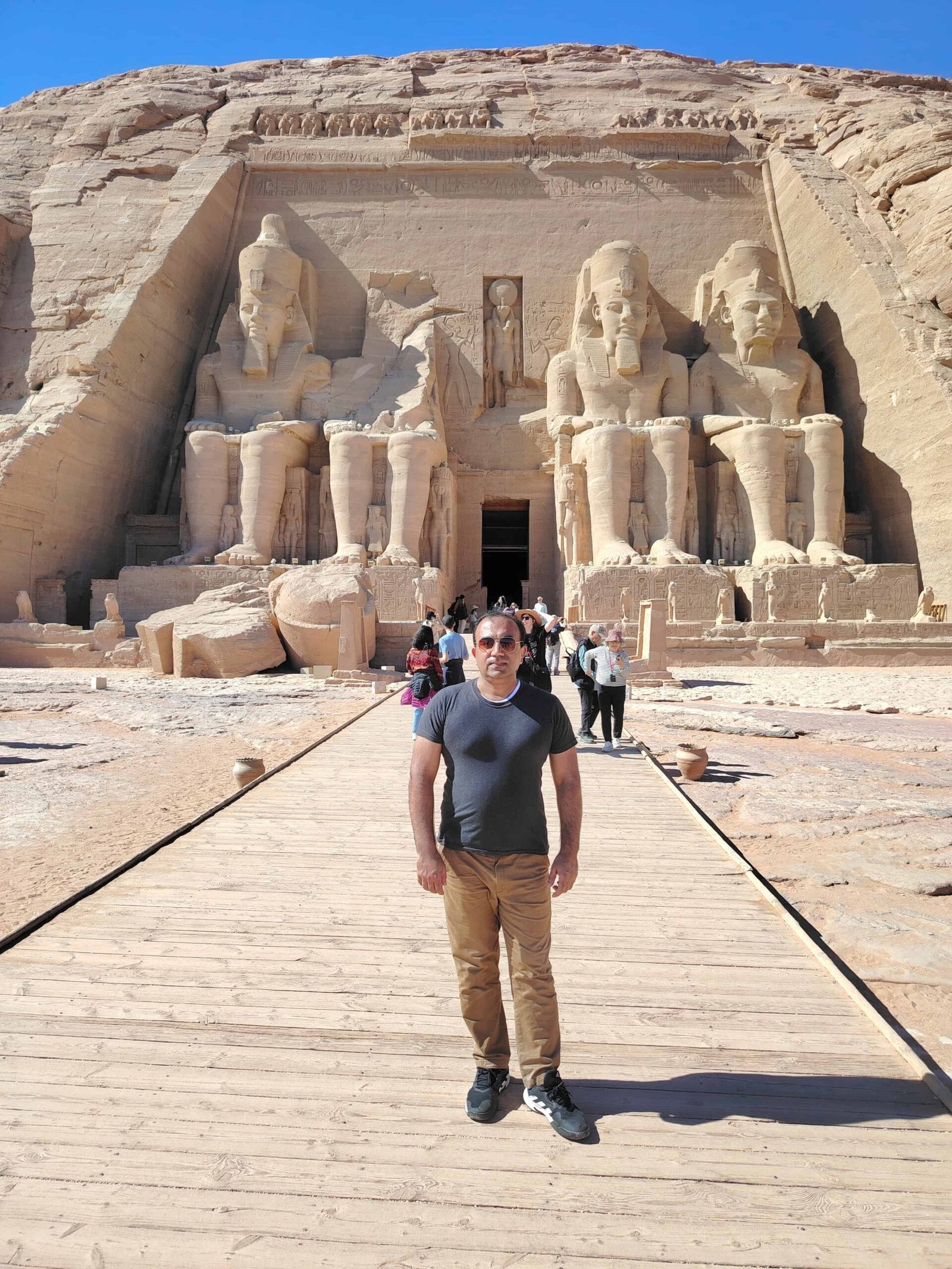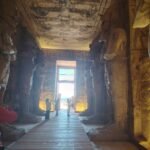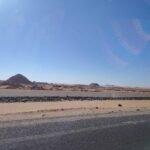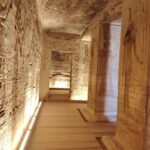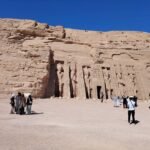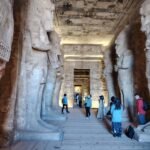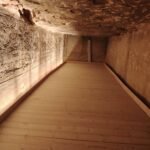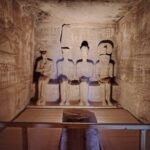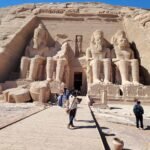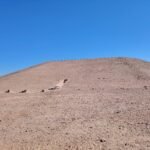Visiting Abu Simbel is widely considered one of the highlights of a trip to Egypt and is often described as a “must-see” for travellers, especially those interested in ancient Egyptian history and monumental architecture. Below are some considerations to help you decide whether it is worth visiting for you:
What is Abu Simbel
- The temples of Ramses II and Nefertari are among the most iconic and impressive structures in Egypt.
- The Great Temple of Ramses II features colossal statues of the pharaoh, each standing over 20 meters tall, carved into the mountainside.
- The smaller Temple of Nefertari, dedicated to the goddess Hathor and Ramses’ favourite queen, is equally stunning in its artistry and historical significance.
Historical and Cultural Significance
- Built during the reign of Ramses II (13th century BCE), Abu Simbel commemorates his military victories and his devotion to the gods.
- The temples showcase ancient Egypt’s engineering prowess and artistic mastery, making them a UNESCO World Heritage Site.
- The relocation of the temples in the 1960s to save them from flooding caused by the Aswan High Dam is a fascinating feat of modern engineering.
Unique Features
- The biannual solar alignment phenomenon is an event when sunlight illuminates the inner sanctuary and the statues of the gods, leaving Ptah (the god of darkness) in shadow. This occurs around in February and October.
- The remote setting on the shores of Lake Nasser adds to the grandeur and mystique of the site.
Considerations
Travel Time
- Abu Simbel is located about 280 km (175 miles) south of Aswan.
- The journey involves either:
- A flight (30–45 minutes each way) from Aswan.
- A road trip (3–4 hours each way) via private car or group tour, often starting very early in the morning.
Costs
- Visiting Abu Simbel can be relatively expensive due to the remote location:
- Entry Fees: Around EGP 765 (about £12) for the temples.
- Transportation: Flights or private tours can add to the cost significantly.
- However, many travellers feel the experience justifies the expense.
Crowds
- Despite the remote location, it’s a popular site, so expect crowds, especially during peak tourist seasons.
Physical Effort
- The trip requires some stamina due to the long travel times and desert heat, but the site itself is easy to navigate.
What is the Solar Alignment?
- The inner sanctuary of the Great Temple houses four seated statues:
- Ra-Horakhty (sun god)
- Amun (king of the gods)
- Ramses II (depicted as a deity)
- Ptah (god of darkness and the underworld)
- During the alignment, sunlight travels through the temple’s long corridor and illuminates the statues of Ra-Horakhty, Amun, and Ramses II, while Ptah remains in shadow, as intended by the ancient architects.
Does the Relocation Affect the Phenomenon?
When the Abu Simbel temples were relocated in the 1960s to avoid flooding caused by the construction of the Aswan High Dam, the temples were carefully dismantled and reassembled 65 meters higher and 200 meters back from their original site.
- The relocation slightly shifted the dates of the solar alignment, which originally occurred on February 21 and October 21.
- Today, the phenomenon happens on February 22 and October 22, but the precision and effect remain largely intact.
Why Are These Dates Significant?
The dates are believed to mark:
- February 21: Ramses II’s ascension to the throne.
- October 21: His birthday (or another significant event in his life).
While these associations are debated, the alignment underscores Ramses II’s connection to the divine and the celestial order.
My personal view and tips for visiting Abu Simbel
- I travelled from Cairo to Aswan in order to visit Abu Simbel, Aswan, and Luxor. The flight took just one hour, which was far more convenient than undertaking the approximately fifteen-hour bus journey to Aswan.
- Upon arrival at Aswan Airport, I had not pre-arranged a taxi. Since neither Careem nor Uber operates in the area, private taxis were the only available option. The taxi drivers initially quoted EGP 400 for the short journey to Aswan City, which is less than a thirty-minute drive. After some negotiation, the fare was reduced to EGP 300; however, it still felt overpriced. Fortunately, I met a traveller from South Korea, and we agreed to share the cost of the taxi fare.
- Whilst we were in the taxi, I suggested the idea of visiting Abu Simbel directly from Aswan. The Korean traveller had also been planning to visit, so I proposed that we go together. At the time, it was around 9 a.m. He was initially hesitant but eventually agreed. The taxi driver offered to take us to Abu Simbel, wait for two hours, and then drive us back to Aswan for a total cost of EGP 4000 (£66). Splitting the cost between the two of us at £33 per person seemed reasonable, as it saved us both time and the effort of arranging alternative transport options.
- The taxi driver agreed to this plan, and we commenced the journey.
- The drive was quite pleasant, consisting of long stretches of desert road. There was a police checkpoint along the route, and we saw several Sudanese individuals as the city is located near the Sudanese border.
- Unfortunately, I found the experience of visiting Abu Simbel somewhat underwhelming. Having already visited the Pyramids and climbed Mount Moses, I did not find it as impressive by comparison. Furthermore, the fact that the entire site had been relocated diminished its impact for me.
- Entry to the temples cost EGP 765.
- Originally, the temples were carved into a mountainside overlooking the Nile River, where they blended seamlessly with their natural surroundings. Today, they rest on an artificial hill above Lake Nasser. Although this reconstruction is an extraordinary engineering achievement, it lacks the natural integration that the original site possessed.
- In my opinion, the relocation resulted in the loss of a significant connection between the temples and their original cultural and natural context. Before they were relocated, visitors could marvel at the fact that the temples had remained undisturbed for over three thousand years, enduring the passage of time exactly as their creators had intended. While the reconstruction is undoubtedly faithful, the knowledge that the temples were dismantled and reassembled diminishes the sense of authenticity and originality.
- I would not visit Abu Simbel again. For me, the experience was worthwhile on this occasion, but it would not justify the expenditure of time, effort, or money for a repeat visit.
Verdict
For most travellers, Abu Simbel is an unforgettable experience and a highlight of their trip to Egypt. The combination of historical significance, architectural grandeur, and the dramatic story of its relocation makes it a bucket-list destination. If your itinerary and budget allow, it’s highly recommended!

